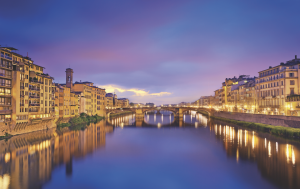Looking upstream into a Florence sunrise almost the colour of the city’s beloved football club’s shirt, we are, in one very real sense, looking towards the source of the Renaissance itself…

The River Arno divides Florence between the north side, where most of the famous bits are, and the Oltrarno, the ‘other side’, where most of us only venture on the last day of our visit, out of a sense of duty perhaps – or maybe even exhaustion – to go and see the Palazzo Pitti and spend a bit of time in the Boboli Gardens digesting the experiences of our sojourn in the City of the Renaissance.
But just as the river divides the city, between the bit that has long been posh and elegant and tourist-friendly (left), and the bit that hasn’t been like that for very long at all (right), so it brings it life. The Arno used to be an important trade route between the mountains and the sea. It was down the Arno, from across the Valdarno (‘Valley of the Arno’) and up into the Tuscan Apennines, that the materials for the city’s construction were first brought. And it was from the Arno that the water was taken to drive the mills that drove the textile industry that helped make Florence rich enough to support the Renaissance in the first place. (Well, banking and the Black Death helped too, but we’re not going into that part of the story now.)
If you go into the horizon of this picture, you will come (after about an hour’s drive, rather more if you are daft enough to try going by boat) to Capo (‘Head’) d’Arno, just short of the border with Emilia Romagna. Behind us (we are standing on the Ponte alla Carraia, looking at the Ponte Santa Trinità), the river flows west, its course more or less followed by the main road, to Empoli, Pontedera and Pisa, then on to Bocca (‘Mouth’) d’Arno at Marina di Pisa, and out into the Tyrrhenian Sea.
